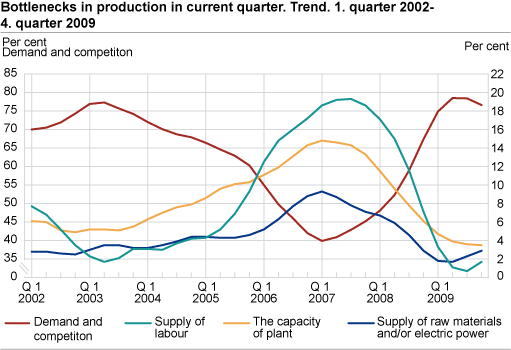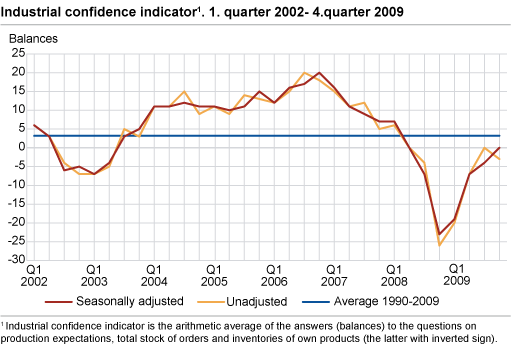Content
Published:
This is an archived release.
Great variations within manufacturing
Norwegian industrial managers report a mixed development within manufacturing. Some sectors experienced an increase in demand due to higher consumption, while others suffered the consequences of a lack of new orders for ships, boats and oil platforms.
According to the business tendency survey, the Norwegian manufacturing industry experienced a further decline in output and employment in the fourth quarter of 2009. However, the fall was not as strong as recorded in previous surveys. Improved conditions for producers of intermediate goods and consumer goods was the reason for this development. However, the recovery has not been sufficient to increase the demand for labour within these sectors. A lack of new orders for capital goods caused total stocks to fall and had a negative effect on market prices. Some of the decline in export prices was also due to a strengthening of the Norwegian currency. Poor demand and fierce competition continued to play a major role in restricting production, while resource shortage ( see table 16 ) was hardly a problem.
The number of working months covered by the current stock of orders was close to the historic average for the manufacturing industry. This is significantly less than the corresponding figure for 2008. Poor demand for ships, boats and oil platforms partly explains this development. Average capacity utilisation is estimated at 76.7 per cent. Huge investments in excess capacity in 2007-08, and a significant drop in demand are the main reasons for the poor result. International comparisons of average capacity utilisation are available from EUROSTAT .
The indicator covering the general short-term outlook (Q1 2010) is changing from negative to neutral. Prospects of improved conditions for producers of intermediate goods and consumer goods explain this result. The industrial confidence indicator is estimated at 0 (seasonally-adjusted net figure) in the fourth quarter. This is significantly higher than recorded in the previous survey, and the result indicates that the decline in the business cycle will come to a halt. International comparisons of the industrial confidence indicator are available from EUROSTAT (EU) and the Swedish National Institute of Economic Research (Sweden).
Expectations of improved demand for intermediate goods
Sectors producing intermediate goods (wood and wood products, paper and paper products, non-metallic mineral products, basic metals etc.) report that the decline in total output was put to a halt in the fourth quarter. Similar results were recorded for the development in new orders and market prices. Improved conditions for producers of wood and wood products, paper and paper products and basic metals explains this change. Low demand and fierce competition continued to play a major role in restricting production, and the number of working months covered by the current stock of orders was well below the historic average. Average capacity utilisation is estimated at 75.8 per cent. This is also a weak result.
The indicator covering the general short-term outlook in these sectors is changing from neutral to positive. A decline in stocks of finished goods and prospects of higher demand support this change.
Grim prospects for producers of capital goods
Sectors producing capital goods (machinery and equipment, ships, boats and oil platforms etc.) experienced a further decline in output and employment, while a lack of new orders caused total stocks to fall. The weak demand was reflected by a decline in market prices. Average capacity utilisation is estimated at 78.9 per cent and was well below the historic average. However, the number of working months covered by the current stock of orders was still quite high.
The general short-term outlook is considered to be poor. Expectations of a further decline in output, new orders and market prices support this conclusion.
Higher production of consumer goods
Sectors producing consumer goods (food products, printing and reproduction, basic pharmaceuticals, furniture etc.) experienced growth in total output. Higher demand from domestic markets was the reason for this development. Home market prices continued to improve, while export prices fell partly due to a strengthening of the Norwegian currency. Average capacity utilisation is estimated at 75 per cent. This is well below the historic average for the industries in question.
The general short-term outlook is considered to be positive. Expectations of a further growth in output and demand explain this result.
| Industry | Prospects | Background | |||||||||||||||||||||||||||||||||||||||||||||||||||||||||||||||||||||||||||||
|---|---|---|---|---|---|---|---|---|---|---|---|---|---|---|---|---|---|---|---|---|---|---|---|---|---|---|---|---|---|---|---|---|---|---|---|---|---|---|---|---|---|---|---|---|---|---|---|---|---|---|---|---|---|---|---|---|---|---|---|---|---|---|---|---|---|---|---|---|---|---|---|---|---|---|---|---|---|---|---|
| Food, beverages and tobacco | + | Higher levels of production, capacity utilisation and demand. More or less unchanged level of employment. The general outlook for Q1 is judged as better by many managers, and further growth in output, demand and domestic market prices is expected. | |||||||||||||||||||||||||||||||||||||||||||||||||||||||||||||||||||||||||||||
| Wood and wood products | + | Many managers report increased levels of production, capacity utilisation and employment. Rise in new orders from the domestic market, while export orders are more or less unchanged. Increase in market prices. Many managers consider the general outlook for Q1 as better. This view is supported by expectations of growth in output and new orders. Domestic market prices are expected to be somewhat lower in the forthcoming quarter. | |||||||||||||||||||||||||||||||||||||||||||||||||||||||||||||||||||||||||||||
| Paper and paper products | +(-) | Many managers report growth in output and capacity utilisation. The level of employment has declined. Rise in new orders from the export market, but market prices have declined. The general outlook for the forthcoming quarter is judged as more or less unchanged. Further increases in production and new orders are expected. Export market prices are expected to decline. | |||||||||||||||||||||||||||||||||||||||||||||||||||||||||||||||||||||||||||||
| Basic chemicals | +(-) | Output, capacity utilisation, and employment are reduced in Q4. Increase in new orders, while market prices have declined. Many managers consider the general outlook for Q1 as better, and the levels of production employment and new orders are expected to rise. Market prices are also expected to increase in Q1. | |||||||||||||||||||||||||||||||||||||||||||||||||||||||||||||||||||||||||||||
| Non-ferrous metals | ++ | A large number of managers report higher levels of production and capacity utilisation. The level of employment is reduced. New orders and market prices, both from the domestic and export market, have increased. There is a distinct reduction in the number of managers reporting that poor demand is limiting production. A great number of managers judge the general outlook for Q1 as better, and further increases in output, new orders and market prices are expected in the forthcoming quarter. | |||||||||||||||||||||||||||||||||||||||||||||||||||||||||||||||||||||||||||||
| Fabricated metal products | -- | Output, capacity utilisation and employment are reduced in Q4. New orders from the domestic and export market have declined, and market prices are reduced. A great number of managers report that poor demand is a limiting factor for production. The general outlook for the forthcoming quarter is considered negative, and a further decline in output, employment, new orders and market prices is expected in Q1. | |||||||||||||||||||||||||||||||||||||||||||||||||||||||||||||||||||||||||||||
| Computer and electrical equipment | -- | Lower levels of production, capacity utilisation and employment. A large number of managers report reduced level of new orders. Market prices are down. The general outlook for Q1 is judged as worse, and a further reduction in output, employment, new orders and market prices is expected. | |||||||||||||||||||||||||||||||||||||||||||||||||||||||||||||||||||||||||||||
| Machinery and equipment | -- | Output, capacity utilisation and employment are reduced in Q4. Many managers report a reduction in new orders received from the domestic and export market. Market prices have declined. Many managers report that poor demand limits production. The general outlook for the forthcoming quarter is considered as negative. A further reduction in output, employment, new orders and market prices is expected in Q1. | |||||||||||||||||||||||||||||||||||||||||||||||||||||||||||||||||||||||||||||
| Ships, boats and oil platforms | -- | Reduced activity with lower levels of production, capacity utilisation and employment. The stock of orders is reduced and many managers report that poor demand is a limiting factor for production. The general outlook is judged as worse, and there are expectations of further reductions in output, employment and new orders. Market prices are expected to decline. | |||||||||||||||||||||||||||||||||||||||||||||||||||||||||||||||||||||||||||||
| Repair, installation of machinery | - | Lower levels of production, capacity utilisation and employment in Q4. New orders and market prices have declined. The general outlook is considered as negative. Lower levels of output, employment and market prices are expected in the forthcoming quarter. New orders from the domestic market are expected to increase, while new orders from the export market are expected to fall. | |||||||||||||||||||||||||||||||||||||||||||||||||||||||||||||||||||||||||||||
| The column for Prospects shows an overall evaluation of the present situation and expected short-term developments using the symbols + and -. The following codes and constellations are used: |
++
+ ~ - -- +(-) +/- |
Very good
Good Stable Poor Very poor Good, but with certain negative indications A situation where the + and - factors even out. |
|||||||||||||||||||||||||||||||||||||||||||||||||||||||||||||||||||||||||||||
Industrial confidence indicator (ICI)The indicator is the arithmetic average of the answers (balances) to the questions on production expectations, total stock of orders and inventories of own products (the latter with inverted sign). The indicator is a guide to the level of industrial production because:
TimelinessThe survey data was collected in the period between 10 December 2009 og 20 January 2010. |
Additional information
The statistics provide current data on the business cycle for manufacturing, mining and quarrying by collecting business leaders’ assessments of the economic situation and the short term outlook.
Contact
-
Edvard Andreassen
E-mail: edvard.andreassen@ssb.no
tel.: (+47) 40 90 23 32
-
Ståle Mæland
E-mail: stale.maeland@ssb.no
tel.: (+47) 95 05 98 88


